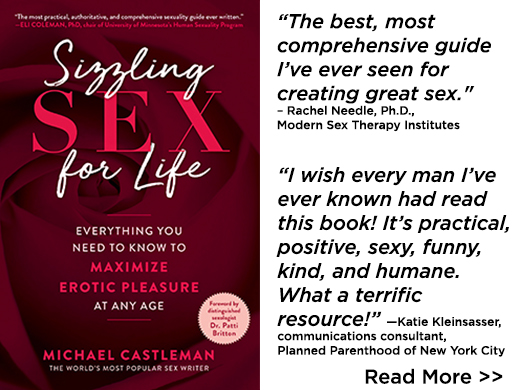
I have been talking to a couple of my buddies about men aging and not having dependable erections any more. So all things considered if you don’t want to be defendant on drugs for the rest of your life we are hearing a lot about a simple penal implant to correct this issue. Easy , dependable , sustainable erections sounds like a win , win , situation for men covered by Medicare too. Have you had any feed back from the woman’s side on how they feel about that? Thanks P.C.
Responses
Leave a Response
You must be logged in to post a comment.




Some women feel fine about their men getting penis implants. Others don’t like the idea. It’s individual. Talk to the woman/women you’re involved with.
Few older men use erection drugs and even fewer get implants. Why? Because most older couples who remain sexual stop having vaginal intercourse. It becomes a hassle. The men have erection issues. And the women have vaginal dryness and tissue thinning (atrophy), which can cause discomfort or pain. Most older couples opt for “outercourse,” everything but intercourse: kissing, hugging, cuddling, mutual whole-body massage, handjobs, fingering, oral sex, toys, and perhaps some anal play or kink.
In addition, implants involve a very expensive roll of the dice with no guarantee you’ll get the desired result. I would never get one. Here’s a blog post I wrote about this issue. If you don’t believe me, just enter the reference citations in a browser to read the studies.
The Dark Side of Penis Surgery
Porn-star phone poles? Erections on demand? Gentlemen, beware of penis surgery
Many surgeons say, “A chance to cut is a chance to cure.” With all due respect to the possibility of cure, some men who opt for surgery to increase their penile girth or treat erectile dysfunction (ED) find the cure worse than the problem:
• University of California, Irvine researchers analyzed the medical records of 11 men (age 21 to 77, average age 47) who’d suffered complications from penile girth enhancement surgery from 2002 to 2016. They’d undergone one of three surgical procedures: injection of silicone under their penile skin, injection of their own body fat, or subcutaneous implantation of silicone strips. In some cases, these operations turn out fine. But many men who consider them don’t fully appreciate the risks. For the men in this study, complications included: infections, penis shortening, unsightly penis deformity (persistent curvature or lumpy appearance), and erectile dysfunction. In all cases, surgeons had to remove whatever had been inserted. Several of the men required multiple corrective surgeries to return to near-normal appearance.
• University of California, San Diego, scientists analyzed state data for 7,666 men who’d had penile prostheses inserted to treat ED. Two types are available—flexible silicone rods or nested hydraulic cylinders.
Silicone rods are the simpler option. The surgeon opens the penile shaft, removes erectile tissue, and inserts a flexible plastic rod. Afterward, recipients have permanent erections that may or may not appear natural. For sex, men bend the rod up. At other times, men bend them down so firmness is relatively inconspicuous, though the rod may cause embarrassment if you wear tight clothing or undress in a locker room.
The hydraulic approach produces more natural looking results, but mechanically it’s more complicated. The surgeon inserts three elements: nested cylinders into the penile shaft, a salt-water reservoir into in the lower abdomen, and a squeeze-bulb pump into the scrotum. The flaccid penis usually looks more or less normal. For erection, the man squeezes the bulb and fluid from the reservoir fills the cylinders producing erection. After ejaculation, a release valve returns the fluid to the reservoir.
In the UCSD analysis, within 10 years of prosthetic insertions, 16 percent of recipients—one in six—needed additional surgery mostly to correct prostheses malfunctions or treat infections that did not respond to antibiotics.
Surgery Has Declined
When it comes to penile surgery, some surgeons overstate the benefits and understate the risks. But many surgeons present more realistic cost-benefit assessments, and media coverage has made many men wary of the knife. As a result, in recent years fewer men opted for surgery.
Cornell investigators reviewed 2001-2010 Medicare data for the 1.7 million U.S. men who were diagnosed with erectile dysfunction (ED). Three percent (53,180) chose surgical insertion of penile prostheses. During that decade, one subgroup of men became more likely to opt for penile surgery, those with compromised their sexual function due to major health problems, usually diabetes and/or heart disease. But overall, penile prostheses insertions fell by half from 4.6 percent to 2.3 percent.
If you think your penis is too small, it probably isn’t—see my previous post on size—and only one woman in eight wishes her man’s were larger. And if you have ED, there are many ways to deal with it, including making love without intercourse, enjoying kissing, cuddling, mutual whole-body massage, hand jobs, oral, toys, and perhaps some kink. Men don’t need erections to have orgasms.
If you decide to have surgery, that’s up to you and your health insurer. Check your policy. But surgery always involves risks, and that goes double for penis surgery.
Furr, J. et. al. “Complications of Genital Enlargement Surgery,” Journal of Sexual Medicine (2018) 15:1811.
Lee, D.J. et al. “Trends in the Utilization of Penile Prostheses in the Treatment of Erectile Dysfunction in the United States,” Journal of Sexual Medicine (2015)12:1638.
Lever, J. et al. “Does Size Matter? Men’s and Women’s Views on Penis Size Across the Lifespan,” Psychology of Men and Masculinity (2006) 7:129.
Mirheydar, H. et al. “Reoperation Rates for Penile Prosthetic Surgery,” Journal of Sexual Medicine (2016) 13:129.